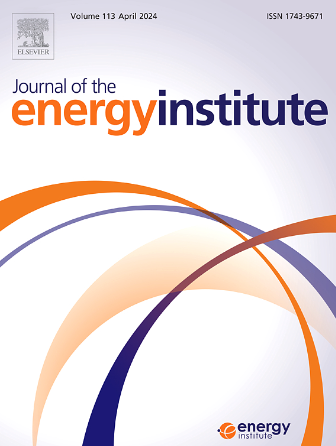Nitrogen migration and transformation in gasification chars prepared from torrefied fiberboard
IF 5.6
2区 工程技术
Q2 ENERGY & FUELS
引用次数: 0
Abstract
Low-temperature thermal conversions can efficiently modify nitrogen configurations in biomass. This study focused on nitrogen migration and transformation during the torrefaction and subsequent gasification of fiberboard (FB), a common bioresource sourced from waste furniture, flooring, etc., which is characterized by high nitrogen content. The results indicated that as torrefaction temperatures reached 230 °C, the nitrogen loss rates in FB gradually decreased with further increased temperatures. This trend was primarily attributed the significant nitrogen loss due to the decomposition of urea formaldehyde (UF) before 230 °C. When the temperature rose to higher levels, the pyrolysis of lignocellulose caused the generation of active oxygen-containing groups, facilitating nitrogen re-fixation in chars. Moreover, amide-N in the FB was converted into more stable forms, pyrrole (N-5) and pyridine (N-6), thereby reducing the conversion of nitrogen into volatile compounds. During the gasification process, as torrefaction temperatures increased, the contents of quaternary nitrogen (N-Q) and nitrogen oxide (N-O) increased in the gasification chars from torrefied FB, while the contents of N-5 and N-6 decreased. This study analyzed the nitrogen migration pathways in torrefaction vs. torrefaction-gasification, exploring potential transformation mechanisms such as deamination reactions, Maillard reactions, and ring condensation reactions. These findings provide a crucial theoretical foundation for optimizing the treatment of waste FB and understanding the nitrogen migration and transformation during torrefaction-gasification integral process.

碳化纤维板气化炭中氮的迁移与转化
低温热转化可以有效地改变生物质中的氮构型。纤维板(FB)是一种常见的生物资源,主要来源于废弃家具、地板等,其氮含量较高,本研究主要研究了纤维板(FB)在热解和随后气化过程中的氮迁移和转化。结果表明,当焙烧温度达到230℃时,随着温度的进一步升高,FB中的氮损失率逐渐降低。这一趋势主要是由于尿素甲醛(UF)在230℃前分解导致氮的大量损失。当温度升高时,木质纤维素的热解产生活性含氧基团,有利于炭中的氮再固定。此外,在FB中酰胺- n转化为更稳定的形式,吡咯(N-5)和吡啶(N-6),从而减少了氮转化为挥发性化合物。在气化过程中,随着焙烧温度的升高,焦炭中季氮(N-Q)和氮氧化物(N-O)含量升高,N-5和N-6含量降低。本研究分析了脱氨反应、美拉德反应和环缩合反应中氮的迁移途径,探讨了脱氨反应、美拉德反应和环缩合反应等潜在的转化机制。这些研究结果为优化废FB处理及了解热解-气化一体化过程中氮的迁移转化提供了重要的理论基础。
本文章由计算机程序翻译,如有差异,请以英文原文为准。
求助全文
约1分钟内获得全文
求助全文
来源期刊

Journal of The Energy Institute
工程技术-能源与燃料
CiteScore
10.60
自引率
5.30%
发文量
166
审稿时长
16 days
期刊介绍:
The Journal of the Energy Institute provides peer reviewed coverage of original high quality research on energy, engineering and technology.The coverage is broad and the main areas of interest include:
Combustion engineering and associated technologies; process heating; power generation; engines and propulsion; emissions and environmental pollution control; clean coal technologies; carbon abatement technologies
Emissions and environmental pollution control; safety and hazards;
Clean coal technologies; carbon abatement technologies, including carbon capture and storage, CCS;
Petroleum engineering and fuel quality, including storage and transport
Alternative energy sources; biomass utilisation and biomass conversion technologies; energy from waste, incineration and recycling
Energy conversion, energy recovery and energy efficiency; space heating, fuel cells, heat pumps and cooling systems
Energy storage
The journal''s coverage reflects changes in energy technology that result from the transition to more efficient energy production and end use together with reduced carbon emission.
 求助内容:
求助内容: 应助结果提醒方式:
应助结果提醒方式:


